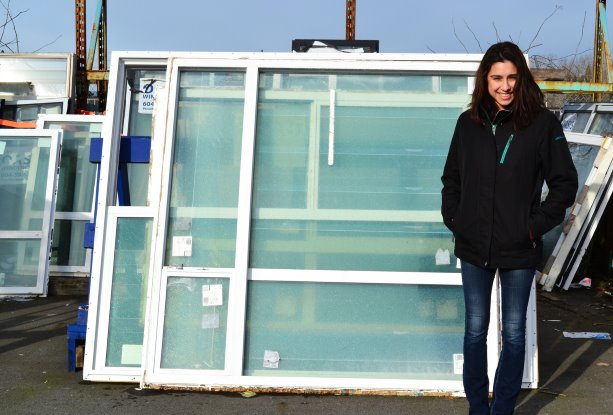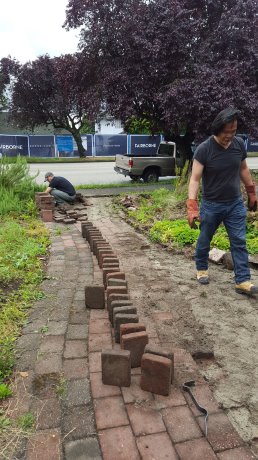The City of Vancouver (CoV) is pushing for more home deconstruction and salvaging of reusable materials such as first-growth wood and architectural features with its Green Demolition Bylaw in place and Habitat for Humanity has launched a deconstruction crew to pick up on the growing trend.
The CoV Green Demolition Bylaw is designed to skirt landfills by sending more material to recycling or salvage operations but is also a red flag to contractors involved in demolition or site work that conservation attitudes are changing.
"The bylaw is currently in place for homes built prior to 1940 (40 per cent of Vancouver’s housing stock)," said Brad Badelt, CoV sustainability group member, but plans are to include homes built prior to 1950 (70 per cent of CoV’s homes) and "then all homes."
The bylaw, implemented in September 2014, demands a minimum of 75 per cent of the home’s weight (excluding hazardous materials) be destined for recycling or salvage. If the home is deemed a character home by the city, then 90 per cent of the home’s weight must be recycling or salvage.
Badelt, a Buildex Vancouver panel member at session W33: Deconstruction and the Green Demolition Bylaw on Feb. 15-16, said the city brought the bylaw, which is similar to those in the U.S., into effect for two reasons. Cities want to reduce landfill materials, but many of these earlier homes contain quality wood and craftsmanship.
"These buildings have old-growth wood and we want to save those materials as well as the architectural details such as the old style windows. We saw a lot of material that could be salvaged and recycled," he said. The bylaw also aligns itself with heritage conservation values in the city.
The other panel members are Adam Corneil, CEO of Naturally Crafted, a construction company that focuses on green renovations, high-end carpentry and deconstruction and Robert Capar, owner of Maison D’Etre Design-Build Inc., an award-winning renovations and design company, who will serve as moderator.
Badelt said the bylaw has diverted landfill materials. Demolition contractors can still use an excavator to demolish a house and then sort the materials such as metals, wood and concrete to be sent to recyclers. But, it is not the end solution the city wants. It is looking for more salvaging of materials from homes, he said and is currently looking at ways to bring these materials to market.
"That is the gap," he said, as the need exists for more outlets where salvaged material can be placed.
However, one group — Habitat for Humanity — is providing an outlet through its B.C. ReStores which take construction materials, furniture and donations from hardware and other retail outlets. It also has a deconstruction team in place in the Lower Mainland to salvage materials.
"We started our deconstruction team July 2015 and over the past year and half have slowly been building up our donor base," said Christina Radvak, Greater Vancouver deconstruction manager, Habitat for Humanity.
The team consists of Habitat staff members working with volunteers. Radvak is also a member of the Buildex panel presenting on deconstruction and green demolition.
"We remove high-value items such as kitchen cabinetry, vanities, appliances, high quality floor, lighting, doors, and windows — these are the most common items," she said, but also included are exterior items such as bricks and pavers. The team has also been working with the CoV promoting the complete deconstruction of homes to salvage usable lumber materials.
Where deconstruction skills surpass those that the team can supply, the general contractor is asked to find a subcontractor to do the work. Radvak said that the general contractor pays the subcontractor and Habitat would issue a tax receipt for the amount in return for harvesting the materials which would go for resale in its B.C. stores.
Radvak said the sales proceeds are used for building housing for low-income individuals and families. Most recently a 27-unit building was completed in Burnaby. She said the individual or family buys into the building with no down payment and pays no monthly interest charge on payments. When the individual or family decides to move, the unit is sold back to the non-profit and monthly payments (usually 30 per cent of their monthly household earnings) are returned to the owner. This allows the individual or family to have a lump-sum as a down payment for a new home.
Buildex panel member Richard Drake, a contractor, said he is currently working with a group of stakeholders and CoV to assemble a business plan for an outlet that would handle salvage material from demolitions.
"We are looking at providing a centralized deconstruction hub," he said.
Drake sees such a facility as also able to provide training for individuals on how to do deconstruction, provide a site for building trades training, certify used lumber, and partner with marketing firms for the resale of usable items. "The city did have this on their radar four years ago but could not establish a business case for it," he said. "It would have to pay for itself and be sustainable."
One of the challenges is gaining a large enough land base to house the construction material in the yard and building. In Vancouver, he said a joint-venture might see the city contributing land in some form to a salvage and sales hub.
Drake, who has been involved in deconstructing houses in Vancouver and other parts of B.C., said "this is really the way it is moving" as larger cities are looking at higher end use of materials from demolition sites.
Another option open to clearing sites for redevelopment is moving houses. Drake, who operated Cumberland Construction Services on Vancouver Island before moving to Vancouver, was involved in moving homes. "It is limited what you can do in Vancouver," he said, as utility lines are expensive to relocate, but for homes located near water and going to a destination that is close to water, it is a viable alternative to reusing a home.
Drake said there are smaller contractors throughout the city that are currently either involved in deconstruction efforts (some in commercial buildings where it is not viable to use machinery) and those companies that use the salvaged material in new construction and renovations. He perceives the need as one of better coordination of supply and demand. Other North American cities such as Portland and Seattle have successfully established salvage and sales centres and have been able to both

1/2
Christina Radvak leads Habitat for Humanity’s deconstruction team which removes useable materials from homes slated for demolition. The materials, construction materials, hardware and other useable goods, are sold through the non-profit society’s ReStores, which are located throughout B.C. ReStores are a popular shopping outlet for do-it-yourselfers and smaller contractors.
Photo: Habitat for Hunaity
2/2
ReStores throughout B.C. are providing an outlet for salvaged material from deconstructed single family homes to condo developments slated for demolition. Crews from Habitat for Humanity which run the stores go to sites and remove useable materials ranging from pavers to lumber.
Photo: Habitat for Humanity"










Recent Comments
comments for this post are closed